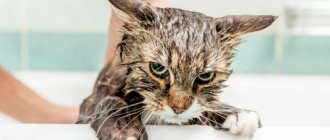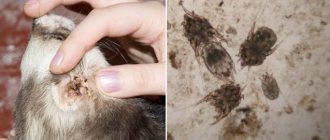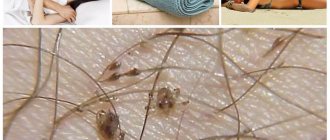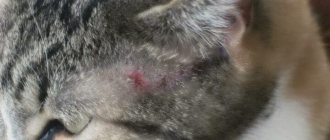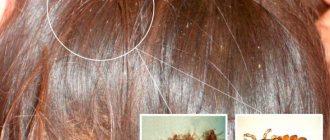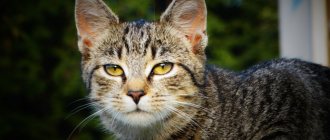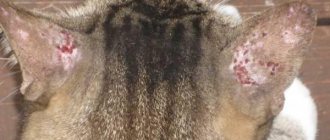The Murkoshi team will help you figure out where lice in cats come from, whether they can be transmitted to humans and how to deal with them. In this article you will learn everything that may interest you about preventing the appearance of lice in your favorite cats. And also about what symptoms may indicate the appearance of an infection.
1) What are lice in cats 2) How can a cat get lice 3) Which cats are at risk 4) How to determine that a kitten has lice 5) Can lice be transmitted from a cat to a person 6) How to remove lice from a cat 7) Prevention of lice at the kitten's
How can a cat get lice?
The main method of transmission of lice is through contact between a cat and an already infected animal. It is also worth noting that these parasites are interrelated with worms. Lice can be transmitted to a cat through tapeworm larvae. The parasite swallows a tapeworm that has hatched from an egg. On the other hand, a cat may accidentally swallow a louse and after some time a tapeworm will begin to grow in the animal’s intestines. An infected pet must be treated not only for lice, but also for worms, since these diseases are closely interrelated
Read more about treatment for worms: Preparations for deworming cats
Most often, lice are especially active in autumn and winter. They are located on the neck, back or chest. And they have the ability to reproduce quickly.
Danger to humans
Since the cat owner is constantly in contact with his pet, he is concerned about the possibility of infecting people with cat lice. This parasite does not pose a direct threat to humans, but care must be taken when caring for a sick animal.
Do people get bitten?
The lice eater cannot bite through human skin.
Is it transmitted from cat to person?
Lice are adapted to living on cat fur; they cannot exist in human hair. If an insect accidentally lands on the body, it is unable to live long. After a few hours, the parasite dies and a person cannot become infected.
Lice cannot pass from cats to humans.
Can human lice spread to cats?
Human lice are not transmitted to cats. If you deliberately plant a parasite on the fur of a pet, it will not take root. The human louse is adapted to consuming blood at a particular temperature. The body of a cat or dog is considered an unfavorable environment for the life of parasites.
How to determine if a kitten has lice
At the initial stages, identifying signs of the disease is quite difficult. But a cat is a smart animal, and she herself begins to give signals when something bothers her. The main sign of lice in a cat is severe itching, which becomes more pronounced every day. Due to constant discomfort, the animal becomes irritable, aggressive and restless. Scratching and redness can occur from scratching.
Another important symptom is severe molting, which is not typical during this period of time. The fur falls out in clumps and forms islands of bald spots. Parasites are immediately visible; they can be noticed if you look deep into the thicket of wool and look closely. In addition, waste products or lice larvae in the form of black dandruff can be seen on the hair. By the way, lice are more noticeable on light-colored cats.
Symptoms of infection
Lice in cats often appear simultaneously with fleas, but they can infect a pet on their own. The following signs may indicate that a cat has pediculosis, or more precisely siphunculatosis (this is what infestation with lice eaters is called):
- severe itching - lice bite off pieces of skin, constantly injure the cat and cause it to itch continuously;
- the appearance of bleeding wounds, abrasions, scratches - both from bites and from scratching;
- shedding - the animal begins to shed its fur, and this is not similar to seasonal shedding: bald spots appear in certain places;
- upon careful examination, you can see accumulations of insects, their excrement, remains of shells, and nits;
- anxiety - the cat behaves unnaturally, constantly itches, rubs itself on its legs and furniture, sleeps poorly, etc.
Can lice be transmitted from cats to humans?
The Murkoshi team is in a hurry to reassure you: cat lice are not transmitted to people. Even if they accidentally come into contact with the human body, the parasites die instantly without causing any harm to people. But due to the fact that lice and worms are interconnected, there is a possibility of infection from lice with other parasitic diseases. These may be infectious diseases or helminth infestations, which may occur due to the fact that lice eggs in cats are potential carriers of helminths.
Diagnostics
Signs of lice in animals resemble allergic dermatitis caused by fleas. Diagnosis is complicated by the fact that a pet can have both fleas and lice at the same time. Sometimes infection is accompanied only by slight peeling. Lice can be identified by careful examination of the skin and fur.
Lice appear as dark, oval-shaped objects. Lice eaters move quickly and are very difficult to catch. Body length – 1–1.5 mm. The sucking louse is less mobile and larger – up to 2 mm. You can see nits - lice eggs attached to the fur.
How to remove lice from a cat
Lice in cats are quite an unpleasant phenomenon for the animals themselves. Therefore, it is very important to take measures to eliminate them immediately after detecting the first symptoms of the disease. Now, understanding what lice in cats are, we can identify the disease in time and provide qualified assistance. We need not only to get rid of parasites, but also to cure the pet of already formed wounds and bald patches. First of all, you need to contact a veterinary clinic. The doctor will confirm the presence of lice and prescribe a course of treatment.
The main thing in treatment is moderation. You should not exceed the indicated dosage of the drug in the hope that the cat will get rid of lice faster. Be sure to ensure that the animal does not reach the treated area with its tongue. Because getting a substance into the oral cavity can cause undesirable consequences in the form of poisoning.
Do an allergy test. If after applying the drug your pet’s condition worsens, stop using it and contact a qualified specialist to correct the course of treatment. As we wrote earlier, an integrated approach is the most important thing in treating lice in cats. This approach involves the use of specialized shampoos, sprays, drops, collars, etc. If you do not immediately notice lice on a cat and do not provide timely help, it may be left without fur.
Lice shampoos should be selected based on the age of the pet and the effect of the detergent. These are special products with insecticides that repel parasites and nits. Such products inhibit insect activity, protecting your pets. Plus, as a bonus, these detergents can soften your kitty's hair and make it look well-groomed.
Shampoo “Ms Kiss” was created by Swiss specialists and can rid a cat of lice after the first use! It is great even for small kittens, starting from four months.
BioVax shampoo is a whole line of special products based on plant extracts. Suitable for the smallest kittens, pregnant and lactating cats.
“Clandestine” shampoo is a common product on the Russian market. Contains aloe, vitamin B5 and permethrin. Destroys nits in one application. Suitable for use by everyone except pregnant cats and kittens under eight months of age.
Read more about how to wash a cat: Should you wash your cat?
Lice sprays also contain insecticides that effectively fight the disease. By the way, after use, such products do not need to be washed off with water!
Bayer Bolfo spray is an absolutely safe and anti-allergenic product. We recommend treating not only the kitten itself for lice, but also its toys, bed, and other things. But, unfortunately, it cannot be used if the cat is under three months old. Use in lactating and pregnant animals should also be avoided.
“Sentry” is suitable for lovers of products based on herbal preparations. The essential oils contained in the composition are excellent at fighting lice due to their very strong odor. After two weeks, a control treatment of the cat will be required. Can be used for all pets starting from 12 months.
Lice drops are the least toxic way to get rid of parasites. They also contain insecticides. Manufacturers advise not to bathe the animal several days before and after wool treatment. In addition, at first, exposure to direct sunlight is contraindicated.
Hartz Ultraguard drops are made in America and are particularly popular and effective. After the first application, lice will leave your cat's fur. There are contraindications for kittens up to three months.
Celandine drops are a Russian remedy that remains effective for two weeks, but is contraindicated for kittens up to eight months of age.
Lice collars are the most durable and safest way to get rid of parasites. It acts as gently as drops and shampoos, repelling nits from your pet. Let us dispel all doubts: collars are absolutely safe for cats. When choosing a manufacturer, you can pay attention to the brands Bars, Doctor Zoo and Bolfo.
Lice
One type of lice parasitizes dogs. These are small (1.6-2.4 mm) wingless insects with a body flattened in the dorsoventral direction. The width of the head is 2-3 times less than the width of the chest. One five-segmented antenna extends from each side of the head. The mouthparts are piercing-sucking type. There are no eyes. The free ends of three pairs of legs, attached to the chest, end in powerful claws, with which the insects cover the hair, firmly fixing themselves on the host. The abdomen, consisting of 8-9 segments, is rounded in males, and with a triangular notch in females.
Lice are permanent ectoparasites. Development according to the type of incomplete transformation (no pupal stage). Females lay eggs (nits), gluing them to the root part of the hair with uterine secretions. The eggs are oblong-oval, white-yellow, shiny. After 1.5-2 weeks, the eggs hatch into larvae similar to the mothers, but smaller in size and light in color. After 20-30 minutes, the larvae begin to suck blood. After three molts (after 14-21 days), the larvae become sexually mature. Lice parasitize only on specific hosts; males and females, as well as their larvae, suck blood.
Prevention of lice in kittens
Compliance with basic precautions is the main method of prevention in the fight against lice. Therefore, we strongly recommend that you do not let your cat roam outside. Self-walking is a potential source of not only a variety of parasites (including lice), but also infections, wounds, injuries, etc.
Read more about self-walking: Self-walking - when freedom means death
Murkoshi specialists advise regularly treating your cat and its household items for nits and parasites. Specialized drops are suitable to protect your pet. For example, Russian drops “BlochNet max” protect a cat from lice for a whole month. Can be applied to the coat once every two months.
Protective collars can be used as an additional means of preventing lice in cats. This is a very convenient, cute accessory that can be used for animals of all ages. When choosing, pay special attention to the size and stiffness of the collar so that your pet feels comfortable in it. As you can see, if you follow simple rules, you can provide your beloved pet with a happy life, without strangers on its fur!
How are they different from fleas?
The differences between a cat flea and a louse include the following signs:
Distinctive features of lice and fleas.
- Appearance. The flea is large in size and has a dark body color.
- The presence of powerful hind legs. This allows the flea to jump. The louse does not have such paws.
- Lifestyle. Fleas move on the skin; lice prefer to live in the animal's fur.
- Reproduction. This stage of the flea's life cycle occurs outside the host's body. The louse lays eggs by stringing them onto hairs.
How to avoid lice infection
To protect yourself and your loved ones from harm, you need to follow several rules in your life:
- Do not use other people's personal hygiene items.
- Do not wear other people's clothing or try on hats.
- While washing your hair, add a few drops of tea tree essential oils. The smell repels lice. And for prevention it is an excellent remedy.
- Do not swim in bodies of water with many people. Especially if they are closed.
- Check your children's heads.
- Frequent itching should be a concern.
Nowadays, lice are not so much a dangerous phenomenon as they are a nuisance. If discovered, do not panic. If done correctly, they will appear fairly quickly. The main thing is to react in time. Take care of yourself and your hair.
Ixodid ticks on a cat
In addition to microscopic ear mites, which are difficult to distinguish with the naked eye, there are also ixodid mites that can have a detrimental effect on the cat’s body.
These blood-sucking parasites are also dangerous because they are carriers of pathogens that can also be dangerous to humans. Most often, this type of parasite affects cats that spend a lot of time in uncontrolled free space, walk in parks, squares, and near forest plantations. Ticks are found on plants and when they come into contact with an animal’s body, they instantly dig into it. Signs that a cat is infected with ixodid ticks is its behavior. The blood-sucking parasite causes not only itching, but also pain. It is clearly visible to the naked eye. A tick that has drunk blood becomes bloated, its belly hangs from the animal’s fur, causing it discomfort and pain. In some countries, there are ixodid ticks, which are carriers of the fever virus. This fact demonstrates how dangerous it can be for a pet to be infected with a parasite.
Treatment in this case consists of removing the tick, which requires the use of special tools. To carry out this procedure, you need to contact a veterinarian. Otherwise, there is a risk of leaving the head of the parasite in the animal’s body, which, unlike the abdomen, is immersed inside. After removing the tick, the bite site is treated with a disinfectant.
To protect cats from ixodid ticks, special sprayers are used that can repel parasites.
It is especially important to have such products on hand for those cat owners who prefer to spend a lot of time with their pets in nature.
Signs of defeat
The activity of lice leads to the development of the following painful symptoms:
- Itching - the louse bites into the edges of the wounds, releasing an allergen that irritates the skin and makes it itch. The same effects are produced by the movement of the parasite on the skin or hair.
- The rash is an allergic response to repeated lice bites. Sensitization occurs, immunocompetent cells extinguish inflammation, destroying surrounding tissues.
- Formation of crusts and scabs. Bacteria multiply in the exposed skin structures, destroy capillaries, and ichor is released, which dries out. The skin cracks, a new portion of blood sweats out, and the process develops.
- The nutrition of the hair follicles is disrupted, hair falls out, and areas of baldness form.
- The secretion that lice use to attach eggs glues the fur together and tangles form. Long-haired cats suffer more than other cats.
- Worms or their fragments are found in the feces.
- When the immune system is weakened, subcutaneous Demodex and Notoedrus mites become active.
It is possible to defeat parasites!
Antiparasitic Complex® - Reliable and safe removal of parasites in 21 days!
- The composition includes only natural ingredients;
- Does not cause side effects;
- Absolutely safe;
- Protects the liver, heart, lungs, stomach, skin from parasites;
- Removes waste products of parasites from the body.
- Effectively destroys most types of helminths in 21 days.
There is now a preferential program for free packaging. Read expert opinion.
Read further:
Deworming drops for cats: list of the best drugs, how to use, price and reviews
Advocate against worms and fleas for cats and dogs: instructions for use, price, reviews
No to ticks: where to order insect repellent treatment?
What do lice eat on the human body, the lifestyle of parasites
Long worms in cats: main types, description and methods of treating parasites in cats
Vetom 1 for cats: instructions on how to give the drug to a cat, reviews and description
Folk remedies for lice
The arsenal of folk remedies also includes many recipes for eliminating lice from pets:
- Homemade shampoo - grate a quarter of baby soap, steam it with boiling water and simmer until smooth. Remove from heat, let the mixture cool, and then add the grated onion, one yolk and 1 tsp. decoction of calendula, chamomile or other medicinal plant.
- Treat the animal's fur with a decoction of wormwood or tansy - 1 tbsp per liter of boiling water is enough. dry or fresh raw materials, boil everything for a couple of minutes over low heat. After removing from the heat, let it cool and set - treat the animal’s fur with it, wrap it in oilcloth and leave it for half an hour, after bathing the cat with shampoo.
- You can add crushed 5-7 cloves of garlic to 700 ml of water, let the infusion brew and rub it into the cat’s withers in the morning so that the animal does not lick it off. This is an analogue of lice drops - the main thing is not to drip it onto the skin of the animal, so as not to burn it, but rather onto the fur.
- Using a saline solution - dissolve a kilogram of table salt in a 10-liter bucket and dip the cat in the saline solution. Try to hold him like this for 5-7 minutes, then rinse his fur with warm, clean water.
Treatment
Therapeutic procedures include the destruction of lice and elimination of signs of dermatitis in cats. Possible complications include helminthiasis and allergic manifestations.
Insecticides are used against lice in the form of emulsoids, drop mixtures, sprays and collars impregnated with repellent. Shampoos are used to get rid of Felicola subrostratus from weakened animals and kittens. They cleanse the cat of lice, but do not prevent a new infestation.
Emulsoids
The active ingredients of insecticides are wax-like substances. Organic solvents form an essence that can be mixed with water. For example, 1 ml of insecticide working solution is mixed with 1 liter of water. Vestrumite is applied to the fur, the mixture settles on the skin, the eluent evaporates, and the active component in the form of a droplet of a wax-like substance interacts with the lipid complexes of the skin. The insect dies when it comes into contact with the poison. The toxin is not absorbed into the blood, so it is safe for cats. For some time (1-2 weeks), the active compound remains toxic to insects, gradually being washed away by the secretion of the sebaceous glands.
Such preparations are extremely cheap and are produced in sealed ampoules, which prevent premature evaporation of the solvent, but their inconvenience is as follows:
- Short period of protection.
- The working solution is unstable and must be used on the day of preparation.
- The drug is toxic if it comes into contact with the wound or the eye.
- The flow of the working solution onto the mucous membranes of the cat is less dangerous than into the blood, but can cause mild poisoning, characterized by the appearance of foamy discharge from the mouth and nervous symptoms.
Therefore, the cat must be dried under a hair dryer or allowed to dry, preventing the licking of the toxic liquid by wearing a restrictive collar.
In addition, treatment with emulsoids must be duplicated no later than two weeks. This is due to the fact that the eggs are protected from the action of the poison. In order for an insect to be poisoned, it must hatch from the egg, and by that time the drug will have expired. To prevent the parasite from reaching sexual maturity and laying eggs, a new portion of insecticide is required. In demand: diazinon, neostomazan, butox.
Drops and sprays
Drip mixtures do not have the disadvantages of emulsoids. They are applied to the withers or distributed along the back. The contents are absorbed by the sebaceous glands, and then, within a month, are released onto the surface of the skin. The destruction of parasites begins a day after application of the drug. The larvae manage to hatch from the eggs before the insecticide expires and die. The disadvantage is the comparative high cost.
Drops in demand: Stronggold, Bars, Frontline, Advantage, Hartz.
Sprays are nothing more than emulsoids that contain additional components. Therefore, the precautions for their use are the same as for emulsoids. The advantages include the absence of the need for immediate use of an aerosol. With proper use, the container with insecticide will last for many months. The disadvantage is the high cost. The drugs from the same manufacturers as the drops are in demand.
Collars and shampoos
Safety neck rings are impregnated with insecticide and provide long-term, up to six months, protection against insects. The action does not begin immediately; before putting on the collar, the lice are exterminated with emulsoids.
The main disadvantage is the allergenic effect on the cat of individual components of the accessory. Therefore, the use of collars for kittens younger than six months is not recommended. They should not be placed on a lactating animal to avoid poisoning the ubiquitous kittens. Collars from companies producing drops and aerosols of the same name are in demand.
Shampoos do not contain toxic substances - only repellents. They are suitable for treating small kittens. After bathing the cat, wash off the shampoo. Lice and fleas scatter. Disadvantage: no prolonged protection. Driven out today, insects can successfully resume their attack on the cat tomorrow.
Treatment of dermatitis
Therapeutic procedures to eliminate concomitant pathologies are aimed at stopping skin inflammation. The severity of the lesion dictates the use of the following groups of drugs:
- Anti-inflammatory.
- Antiseptic.
- Antimycotic.
- Wound healing.
The vast majority of dermatitis of parasitic etiology develops in the same way. Initially, the skin is exposed to mechanical and allergic irritation. Then the inflammatory process is complicated by the addition of fungi and bacteria.
The following funds are in demand:
- Migstim. Anti-inflammatory spray.
- Vedinol. Antiseptic ointment.
- Anandin. Anti-inflammatory ointment.
- Zooderm. Antiphlogistic liquid.
- Epacid-F Antimycotic drug.
- Terramycin spray. Antiseptic.
- Stop Itching Spray.
Preventive measures
To prevent the massive spread of parasites and maintain the health of your pet, it is necessary to adhere to certain preventive measures.
Basic recommendations:
- regularly inspect your cat's fur and skin for lice and fleas;
- carry out seasonal work with special equipment;
- provide a balanced diet to strengthen the immune system;
- treat not only the animal, but also its belongings with special preparations;
- Treat all scratches and wounds promptly.

